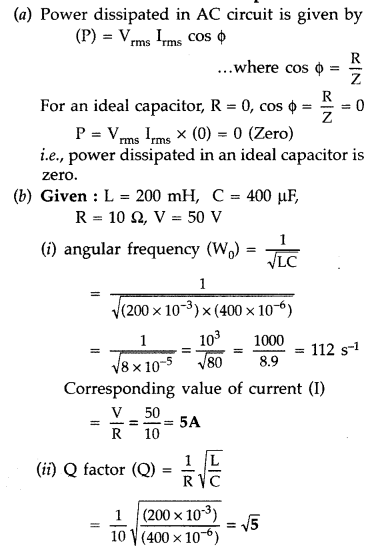Important Questions for Class 12 Physics Chapter 7 Alternating Current Class 12 Important Questions
FalK:
Question 1.
The instantaneous current and voltage of an a.c. circuit are given by i = 10 sin 300 t A and V = 200 sin 300 t V. What is the power dissipation in the circuit? (All India 2008)
Answer:
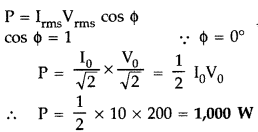
Question 2.
The instantaneous current and voltage of an a.c. circuit are given by i = 10 sin 314 t A and v = 50 sin 314 t V. What is the power dissipation in the circuit? (All India 2008)
Answer:
![]()
Question 3.
The instantaneous current and voltage of an a.c. circuit are given by i = 10 sin 314 tA and v = 50 sin \(\left(314 t+\frac{\pi}{2}\right)\)V. (All India 2008)
Answer:
![]()
Phase difference between current voltage

Question 4.
Define the term ‘wattless current’. (Delhi 2011)
Answer:
Wattless current is that component of the circuit current due to which the power consumed in the circuit is zero.
Question 5.
Mention the two characteristic properties of the material suitable for making core of a transformer. (All India 2012)
Answer:
Characteristic properties of material suitable for core of a transformer :
- It should have high permeability
- It should have low hysteresis loss.
- It should have low coercivity/retentivity.
- It should have high resistivity. (Any two)
Question 6.
When an ac source is connected across an ideal inductor, show on a graph the nature of variation of the voltage and the current over one complete cycle. (Comptt. Delhi 2012)
Answer:
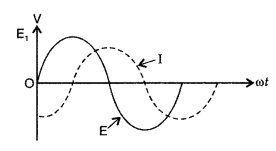
Question 7.
A heating element is marked 210 V, 630 W. What is the value of the current drawn by the element when connected to a 210 V dc source? (Delhi 2013)
Answer:
![]()
Question 8.
A heating element is marked 210 V, 630 W. Find the resistance of the element when connected to a 210 V dc source.
Answer:

Question 9.
Why is the core of a transformer laminated? (Comptt. Delhi 2013)
Answer:
The core of a transformer is laminated to minimize eddy currents in the iron core.
Question 10.
Why is the use of a.c. voltage preferred over d.c. voltage? Give two reasons. (All India 2013)
Answer:
a.c. voltage is preferred over d.c. voltage because of following reasons :
- it can be stepped-up or stepped-down by a transformer.
- carrying losses are much less.
Question 11.
Define capacitor reactance. Write its S.I. units. (Delhi 2015)
Answer:
‘Capacitor reactance’ is defined as the opposition to the flow of current in ac circuits offered by a capacitor.
![]()
S.I. Unit : Ohm.
Question 12.
A variable frequency AC source is connected to a capacitor. Will the displacement current change if the frequency of the AC source is decreased? (Comptt. All India 2015)
Answer:
On decreasing the frequency of AC source, reactance, \(x_{C}=\frac{1}{\omega C}\) will increase, which will lead to decrease in conduction current. In this case
I
D
= I
C
Hence, displacement current will decrease.
Question 13.
Plot a graph showing variation of capacitive reactance with the change in the frequency of the AC source. (Comptt. All India 2015)
Answer:
Graph showing a variation of x
c
capacitive reactance with the change in frequency of AC source.
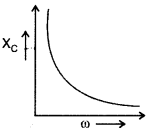
Question 14.
Define ‘quality factor’ of resonance in series LCR circuit. What is its SI unit? (Delhi 2016)
Answer:
Quality factor (Q) is defined as, Q = \(\frac{\omega_{0} L}{R}\)
It gives the sharpness of the resonance circuit. It has no SI unit.
Question 15.
For an ideal inductor, connected across a sinusoidal ac voltage source, state which one of the following quantity is zero :
(i) Instantaneous power
(ii) Average power over full cycle of the ac voltage source (Comptt. All India 2016)
Answer:
Average power over full cycle of the ac voltage source is zero, when connected with an ideal inductor.
transformer
Question 16.
Prove that an ideal capacitor in an a.c. circuit does not dissipate power. (Delhi 2008)
Answer:
Average power associated with a capacitor :
When an a.c. is applied to a capacitor, the current leads the voltage in phase by \(\frac{\pi}{2}\)radian. So we write the expressions for instantaneous voltage and current as follows :

Work done in the circuit in small time dt will be

The average power dissipated per cycle in the capacitor is,

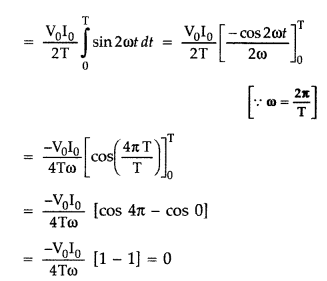
Thus the average power dissipated per cycle in a capacitor is zero.
Question 17.
Prove that an ideal inductor does not dissipate power in an a.c. circuit. (Delhi 2016)
Answer:
Average power associated with an inductor.
When a.c. is applied to an ideal inductor,current lags behind the voltage in phase by \(\frac{\pi}{2}\) radian. So we can write the instantaneous values of voltage and current as follows :
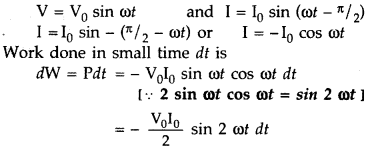
The average power dissipated per cycle in the inductor is
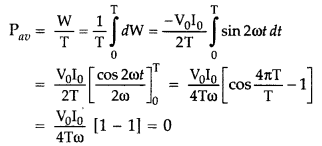
Thus, the average power dissipated per cycle in an inductor is zero.
Question 18.
Derive an expression for the impedance of an a.c. circuit consisting of an inductor and a resistor. (Delhi 2008)
Answer:
From the phasor diagram, we get R
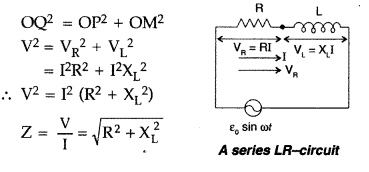
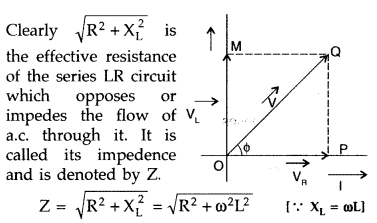
Thus the average power dissipated per cycle in a capacitor is zero.
Question 19.
The circuit arrangement as shown in the diagram shows that when an a.c. passes through the coil A, the current starts flowing in the coil B.
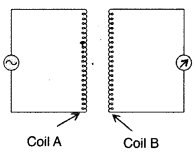
(i) State the underlying principle involved.
(ii) Mention two factors on which the current produced in the coil B depends.(All India 2008)
Answer:
(i) It is based on the principle of “mutual induction”.
(ii) Two factors are:
- distance between the coils.
- orientation of the coils.
- Number of turns in the coil, (any two)
Question 20.
The figure given shows an arrangement by which current flows through the bulb (X) connected with coil B, when a.c. is passed through coil A.
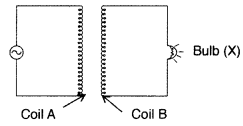
(i) Name the phenomenon involved.
(ii) If a copper sheet is inserted in the gap between the coils, explain, how the brightness of the bulb would change. (All India 2008)
Answer:
(i) The phenomenon involved is mutual induction.
(ii) When the copper sheet is inserted, eddy currents are set up in it which opposes the passage of magnetic flux. The induced emf in coil B decreases. This decreases the brightness of the bulb.
Question 21.
A 15.0 µF capacitor is connected to 220 V, 50 Hz source. Find the capacitive reactance and the rms current. (All India 2009)
Answer:
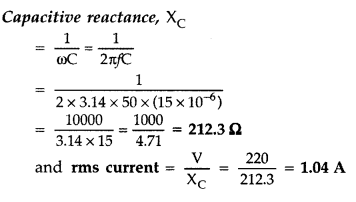
Question 22.
An electric lamp having coil of negligible inductance connected in series with a capacitor and an a.c. source is glowing with certain brightness. How does the brightness of the lamp change on reducing the
(i) capacitance, and
(ii) the frequency? Justify your Answer. (Delhi 2009)
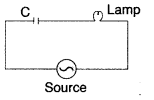
Answer:
Brightness of lamp \(\propto\) I
0
,
Assuming zero resistance and zero inductance of lamp

On reducing C or v; It would decrease
∴ Brightness of the lamp will decrease.
Question 23.
State the principle of working of a transformer. Can a transformer be used to step up or step down a d.c. voltage? Justify your Answer. (All India 2009)
Answer:
Transformer works on the principle of mutual induction, i.e., when a changing current is passed through one of the two inductively coupled coils, an induced emf is set up in the other coil.
cannot
Question 24.
Mention various energy losses in a transformer. (All India 2009)
Answer:
(i) A transformer is an electrical device for converting an alternating current at low voltages into that at high voltage or vice versa.
If it increases the input voltage, it is called step- up-transformer.
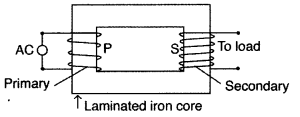
Principle : It works on the principle of mutual induction i.e., “when a changing current is passed through one of the two inductively coupled coils, an induced emf is set up in the other coil.”
Working : As the alternating current flows through the primary, it generates an alternating magnetic flux in the core which also passes through the secondary. This changing flux sets up an induced emf in the secondary, also a self- induced emf in the primary. If there is no leakage of magnetic flux, then flux linked with each turn
of the primary will be equal to that linked with each turn of the secondary.
![]()
…where [N
p
and N
s
are number of turns in the primary and secondary respectively,
V
p
and V
s
are their respective voltages]

This ratio \(\frac{\mathrm{N}_{\mathrm{S}}}{\mathrm{N}_{\mathrm{P}}}\) is called the turns ratio.
Assuming the transformer to be ideal one, so that there are no energy losses, then
Input power = output power
V
p
l
p
= V
S
I
S
…where [I
P
and I
S
are the current in the primary and secondary respectively

In a step up transformer, N
s
> N
p
i.e., the turns ratio is greater than 1 and therefore V
s
> V
p
.
The output voltage is greater than the input voltage.
be
- The primary resistance and current are small.
- The same flux links both with the primary and secondary windings as the flux leakage from due core is negligible (small).
- The terminals of the secondary are open or the current taken from it, is small, (any two)
used
(ii) Two sources of energy loss in a transformer:
1. Copper loss”: Some energy is lost due to heating of copper wires used in the primary and secondary windings. This power loss (= I
2
R) can be minimised by using thick copper wires of low resistance.
to
step
Question 25.
State the underlying principle of a transformer.
How is the large scale transmission of electric energy over long distances done with the use of transformers? (All India 2012)
Answer:
A transformer is an electrical device for converting an alternating current at low voltages into that at high voltage or vice versa.
If it increases the input voltage, it is called step- up-transformer.

Principle : It works on the principle of mutual induction i.e., “when a changing current is passed through one of the two inductively coupled coils, an induced emf is set up in the other coil.”
Working : As the alternating current flows through the primary, it generates an alternating magnetic flux in the core which also passes through the secondary. This changing flux sets up an induced emf in the secondary, also a self- induced emf in the primary. If there is no leakage of magnetic flux, then flux linked with each turn
of the primary will be equal to that linked with each turn of the secondary.
![]()
…where [N
p
and N
s
are number of turns in the primary and secondary respectively,
V
p
and V
s
are their respective voltages]

This ratio \(\frac{\mathrm{N}_{\mathrm{S}}}{\mathrm{N}_{\mathrm{P}}}\) is called the turns ratio.
Assuming the transformer to be ideal one, so that there are no energy losses, then
Input power = output power
V
p
l
p
= V
S
I
S
…where [I
P
and I
S
are the current in the primary and secondary respectively

In a step up transformer, N
s
> N
p
i.e., the turns ratio is greater than 1 and therefore V
s
> V
p
.
The output voltage is greater than the input voltage.
up
- The primary resistance and current are small.
- The same flux links both with the primary and secondary windings as the flux leakage from due core is negligible (small).
- The terminals of the secondary are open or the current taken from it, is small, (any two)
or
Question 26.
A light bulb is rated 100 W for 220 V ac supply of 50 Hz. Calculate
(i) the resistance of the bulb;
(ii) the rms current through the bulb. (All India 2012)
Answer:

Question 27.
A light bulb is rated 200 W for 220 V ac supply of 50 Hz. Calculate
(i) the resistance of the bulb;
(ii) the rms current through the bulb. (All India 2012)
Answer:

Hint: (i) 242Ω
(ii) I
rms
= 0.90 atmosphere
Question 28.
A light bulb is rated 150 W for 220 V ac supply of 60 Hz. Calculate
(i) the resistance of the bulb; ,
(ii) the rms current through the bulb. (All India 2012)
Answer:

Hint :
(i) P = 322.67 Ω
(ii) I
rms
= 0.68 ampere
Question 29.
An alternating voltage given by V = 140 sin 314 t is connected across a pure resistor of 50 Ω. Find
(i) the frequency of the source.
(ii) the rms current through the resistor. (All India 2012)
Answer:
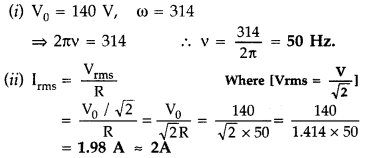
Question 30.
An alternating voltage given by V = 280 sin 50πt is connected across a pure resistor of 40 Ω. Find
(i) the frequency of the source.
(ii) the rms current through the resistor. (All India 2012)
Answer:

Hint:
(i) v = 25 Hz
(ii) I
rms
= 4.95 A
Question 31.
An alternating voltage given by V = 70 sin 100πt is connected across a pure resistor of 25 Ω . Find
(i) the frequency of the source.
(ii) the rms current through the resistor. (All India 2012)
Answer:

(i) v = 50Hz
(ii) I
rms
= 1.98 Ampere.
Question 32.
A lamp is connected in series with a capacitor. Predict your observation when this combination is connected in turn across
(i) ac source and
(ii) a ‘dc’ battery. What change would you notice in each case if the capacitance of the capacitor is increased? (Comptt. Delhi 2012)
Answer:
When dc source is connected, the condenser is charged but no current flows in the circuit, therefore, the lamp does not glow. No change occurs even when capacitance of capacitor is increased.
When ac source is connected, the capacitor offers capacitive reactance \(X_{c}=\frac{1}{\omega C}\). The current flows in the circuit and the lamp glows. On increasing capacitance, X c decreases. Therefore, glow pf the bulb increases.
Question 33.
A capacitor ‘C’, a variable resistor ‘R’ and a bulb ‘B’ are connected in series to the ac mains in a circuit as shown. The bulb glows with some brightness. How will the glow of the bulb change if
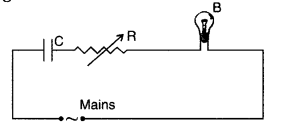
(i) a dielectric slab is introduced between the plates of the capacitor, keeping resistance R to be the same;
(ii) the resistance R is increased keeping the same capacitance? (Delhi 2012)
Answer:
(i) Brightness will increase due to increase in capacitance on introducing dielectric slab.
(ii) Brightness will decrease, as the resistance (R) is increased, the potential drop across the bulb will decrease (since both are connected in series).
Question 34.
The figure shows a series LCR circuit connected to a variable frequency 200 V source with L = 50 mH, C = 80 µF and R = 40 Ω.
Determine
(i) the source frequency which derives the circuit in resonance;
(ii) the quality factor (Q) of the circuit. (Comptt. All India 2014)
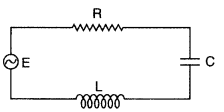
Answer:
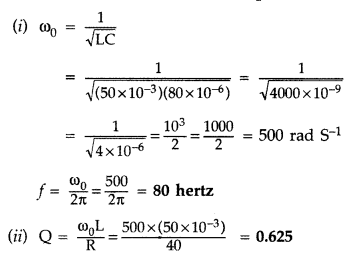
Question 35.
The figure shows a series LCR circuit connected to a variable frequency 250 V source with L = 40 mH, C = 100 µF and R = 50 Ω.
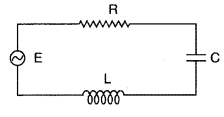
Determine :
(i) the source frequency which derives the circuit in resonance;
(ii) The quality factor (Q) of the circuit. (Comptt. All India 2014)
Answer:

[Hint]:
(i) 80 Hz
(ii) Q = 0.4.
step
Question 36.
An inductor of unknown value, a capacitor of 100 μF and a resistor of 10 Ω are connected in series to a 200 V. 50 Hz a.c. source. It is found that the power factor of the circuit is unity. Calculate the inductance of the inductor and the current amplitude. (Delhi 2008)
Answer:
As power factor of circuit is unity :
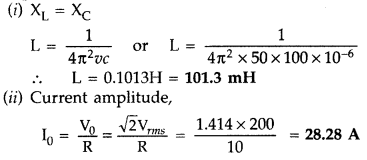
Question 37.
Two heating elements of resistances R
1
and R
2
when operated at a constant supply of voltage, V, consume powers P
1
and P
2
respectively. Deduce the expressions for the power of their combination when they are, in turn, connected in
(i) series and
(ii) parallel across the same voltage supply. (All India 2008)
Answer:
When two resistances R
1
and R
2
are operated at a constant voltage supply V, their consumed power will be P
1
and P
2

When they are connected in series, Power will be

Question 38.
The figure shows a series LCR circuit with L = 5.0 H, C = 80 μF, R = 40 Ω connected to a variable frequency 240 V source. Calculate
(i) The angular frequency of the source which drives the circuit at resonance.
(ii) The current at the resonating frequency.
(iii) The rms potential drop across the capacitor at resonance. (Delhi 2008)
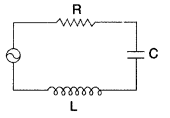
Answer:
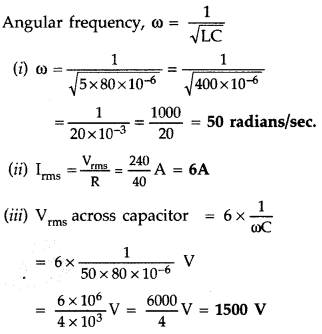
Question 39.
A series LCR circuit with L = 4.0 H,C = 100 μF and R = 60 Ω. is connected to a variable frequency 240 V source as shown in the figure.
Calculate :
(i) the angular frequency of the source which derives the circuit at resonance;
(ii) the current at the resonating freqency;
(iii) the rms potential drop across the inductor at (Delhi 2008)
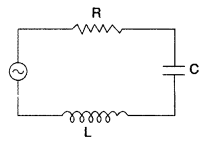
Answer:
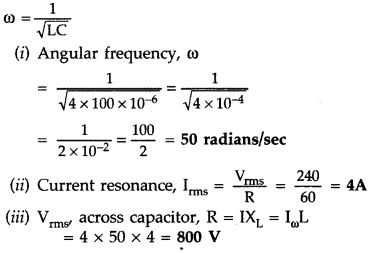
Question 40.
The figure shows a series LCR circuit with L = 10.0 H, C = 40 μF, R = 60 Ω connected to a variable frequency 240 V source.
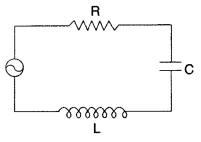
Calculate:
(i) The angular frequency of the source which drives the circuit at resonance.
(ii) The current at the resonating frequency.
(iii) The rms potential drop across the inductor at resonance. (Delhi 2008)
Answer:

(i) Angular frequency, to = 50 ‘radiance/sec.
(ii) I
rms
= 4A
(iii) V
rms
= I
rms
X
c
= 2000 V
Question 41.
A series LCR circuit is connected to an ac source. Using the phasor diagram, derive the expression for the impedance of the circuit. Plot a graph to show the variation of current with frequency of the source, explaining the nature of its variation. (All India 2008)
Answer:
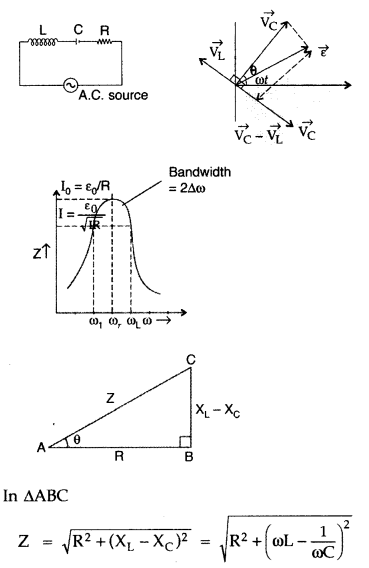
Question 42.
(a) The graphs
(i) and
(ii) shown in the figure represent variation of opposition offered by the circuit elements, X and Y, respectively to the flow of alternating current vs. the frequency of the applied emf. Identify the elements X and Y.
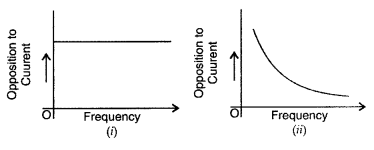
(b) Write the expression for the impedance offered by the series combination of these two elements connected to an ac source of voltage V = V
0
sin ωt.
Show on a graph the variation of the voltage and the current with ‘out’ in the circuit. (Comptt. All India 2008)
Answer:
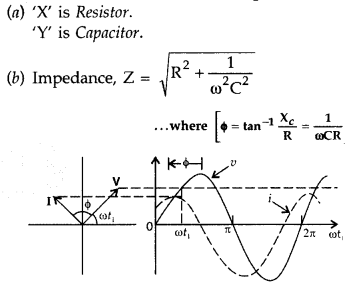
Question 43.
Draw a sketch showing the basic elements of an a.c. generator. State its principle and explain briefly its working. (Comptt. All India 2008)
Answer:
(a) Principle of A.C. generator : The working of an a.c. generator is based on the principle of electromagnetic induction. When a closed coil is rotated in a uniform magnetic field with its axis perpendicular to the magnetic field, the magnetic flux linked with the coil changes and an induced emf and hence a current is set up in it.
(b) Let N = number of turns in the coil
A = Area of face of each turn
B = magnitude of the magnetic field
θ = angle which normal to the coil makes with field B at any instant
ω = the angular velocity with which coil rotates
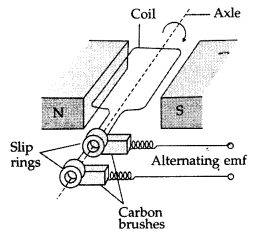
The magnetic flux linked with the coil at any instant f will be,
ϕ = NAB cos θ = NAB cos ωt
By Faraday’s flux rule, the induced emf is given by,

When a load of resistance R is connected across the terminals, a current I flows in the external circuit.
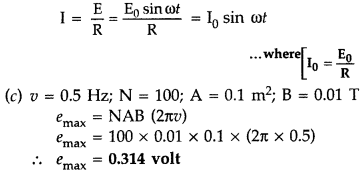
Question 44.
In a series LCR circuit connected to an ac source of variable frequency and voltage v = V
m
sin ωt, draw a plot showing the variation of current (I) with angular frequency (ω) for two different values of resistance R
1
and R
2
(R
1
> R
2
). Write the condition under which the phenomenon of resonance occurs. For which value of the resistance out of the two curves, a sharper resonance is produced? Define Q-factor of the circuit and give its significance. (Delhi 2013)
Answer:
(a) Condition for resonance to occur is X
L
= X
C
, and Z = R.
(b) Sharper resonance is produced for R
2
(c) The Q-factor (quality factor) of series resonant circuit is defined as the ratio of the voltage developed across the inductance of capacitance at resonance to the impressed voltage, which is the voltage applied across the R.
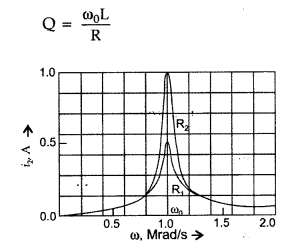
Significance : Higher the value of Q, the narrower and sharper is the resonance and therefore circuit will be more selective
Question 45.
(i) For a given a.c., i = i
m
sin ωt, show that the average power dissipated in a resistor R over a complete cycle is \(\frac{1}{2} i_{m}^{2} \mathbf{R}\).
(ii) A light bulb is rated at 100 W for a 220 V a.c. supply. Calculate the resistance of the bulb. (All India 2013)
Answer:
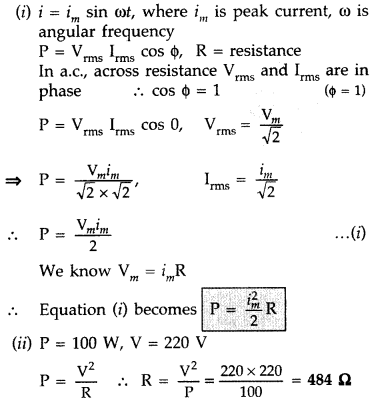
Question 46.
(a) For a given a.c., i = i
m
sin ωt, show that the average power dissipated in a resistor R over complete cycle is \(\frac{1}{2} i_{m}^{2} \mathbf{R}\).
(b) A light bulb is rated at 125 W for 250 V a.c. supply. Calculate the resistance of the bulb. (All India 2013)
Answer:

(ii) P = 125 W, V = 250 V
Where P = Power and V = Voltage

Question 47.
(a) When an a.c. source is connected to an ideal capacitor show that the average power supplied by the source over a complete cycle is zero.
(b) A lamp is connected in series with a capacitor. Predict your observations when the system is connected first across a d.c. and then an a.c. source. What happens in each case if the capacitance of the capacitor is reduced? (Comptt. Delhi 2013)
Answer:
(a) Average power associated with a capacitor :
When an a.c. is applied to a capacitor, the current leads the voltage in phase by \(\frac{\pi}{2}\)radian. So we write the expressions for instantaneous voltage and current as follows :

Work done in the circuit in small time dt will be

The average power dissipated per cycle in the capacitor is,


Thus the average power dissipated per cycle in a capacitor is zero.
(b) (i) In this case, the bulb will glow initially for a very short Bulb duration depending upon its time constant during the charging of capacitor. Once the capacitor is fully charged, it will not allow current to pass, hence the bulb ceases to glow.
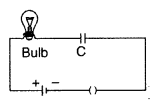
(ii) In this case, when connected to a.c. source, the bulb will glow with the same brightness.
When the capacity of capacitor is reduced, it will have no appreciable effect when connected to d.c. source.
However, in case when connected to a.c. source, capacitance is reduced, hence

![]()
\(\chi_{\mathrm{C}}\) capactive reactance will increase and thus the brightness of bulb will reduce.
Question 48.
A voltage V = V
0
sin est is applied to a series LCR circuit. Derive the expression for the average power dissipated over a cycle.
Under what condition is
(i) no power dissipated even though the current flows through the circuit,
(ii) maximum power dissipated in the circuit? (All India 2014)
Answer:
Average power in LCR circuit :
Let the alternating emf applied to an LCR circuit,
V = V
0
sin ωt …(i)
If alternating current developed lags behind the applied emf by a phase angle ϕ
then, I = I
0
sin(ωt – ϕ ) …(ii)
Total work done over a complete cycle is,
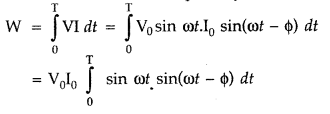
∴ Average power in LCR circuit over complete cycle is,
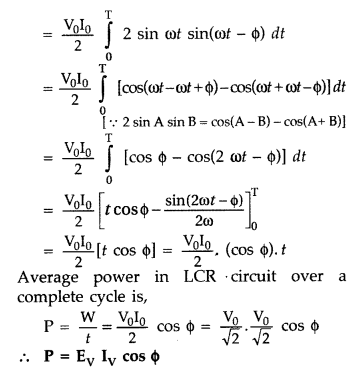
(i) No power is dissipated in purely inductive or purely capacitive circuit, because phase difference between voltage and current is \(\frac{\pi}{2}\) and cos ϕ = 0. It is known as wattless current.
(ii) Maximum power is dissipated in a LCR circuit at Resonance, because X
C
– X
L
= 0 and ϕ = 0, cos ϕ = 1
Power = I
2
Z = I
2
R
Question 49.
An inductor L of inductance X
L
is connected in series with a bulb B and an ac source. How would brightness of the bulb change when
(i) number of turns in the inductor is reduced,
(ii) an iron rod is inserted in the inductor and
(iii) a capacitor of reactance X
C
= X
L
is inserted in series in the circuit. Justify your Answer in each case. (Delhi 2015)
Answer:
(i) Increases. X
L
= ωL
As number of turns decrease, L decreases, hence current through the bulb increases. Also voltage across bulb increases.
(ii) Decreases : Iron rod increases the inductance which increases X
L
, hence current through the bulb decreases./Voltage across the bulb decreases.
(iii) Increases. Under this condition (X
C
= X
L
) the current through the bulb will become maximum.
Question 50.
(a) Determine the value of phase difference between the current and the voltage in the given series LCR circuit.
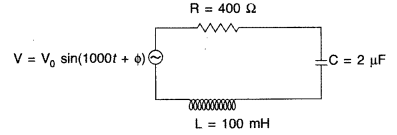
(b) Calculate the value of the additional capacitor which may be joined suitably to the capacitor C that would make the power factor of the circuit unity. (All India 2014)
Answer:
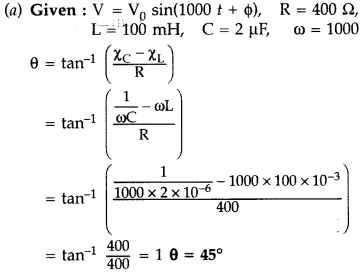
(b) Let the additional capacitor be C’ which is to be connected in parallel with C, to increase the value of combined capacitances; hence resulting into ‘capacitive reactance’ reduced. In parallel C
net
= C + C’
When the power factor is unity
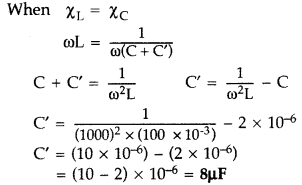
Question 51.
A circuit containing an 80 mH inductor and a 250 µF capacitor in series connected to a 240 V, 100 rad/s supply. The resistance of the circuit is negligible.
(i) Obtain rms value of current. ‘
(ii) What is the total average power consumed by the circuit? (Comptt. Delhi 2014)
Answer:
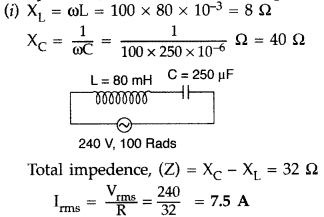
(ii) Average power consumed = 0 (Zero)
(As there is no ohmic resistance in the current)
Question 52.
A source of ac voltage V = V
0
sin cat is connected to a series combination of a resistor ‘R’ and a capacitor ‘C’. Draw the phasor diagram and use it to obtain the expression for
(i) impedance of the circuit and
(ii) phase angle. (Comptt. All India 2014)
Answer:
Phasor diagram and circuit diagram for the given circuit are,
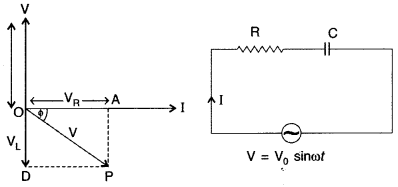
Expression for impedance and phase angle : A resistor and a capacitor are connected in series to a source of alternating current, V = V
0
sin ωt
Let ‘I’ be the instantaneous value of current in this circuit.
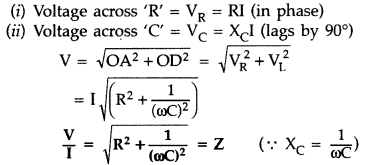
Which is the effective resistance of L – C circuit and is called its ‘impedance’
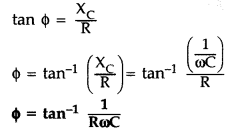
Question 53.
(i) When an AC source is connected to an ideal inductor show that the average power supplied by the source over a complete cycle is zero.
(ii) A lamp is connected in series with an inductor and an AC source. What happens to the brightness of the lamp when the key is plugged in and an iron rod is inserted inside the inductor? Explain.

Answer:
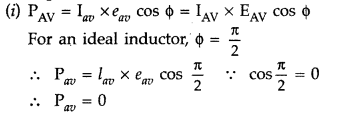
(ii) Brightness decreases because as iron rod is inserted its value of inductance increases. Thus, current decreases and also brightness decreases.
Question 54.
Derive the expression for the average power dissipated in a series LCR circuit for an ac source of a voltage, v = v
m
sin ωt, carrying a current, i = i
m
sin(ωt + ϕ ).
Hence define the term “Wattless current”. State under what condition it can be realized in a circuit. (Comptt. Delhi 2014)
Answer:
Average power in LCR circuit :
Let the alternating emf applied to an LCR circuit,
V = V
0
sin ωt …(i)
If alternating current developed lags behind the applied emf by a phase angle ϕ
then, I = I
0
sin(ωt – ϕ ) …(ii)
Total work done over a complete cycle is,

∴ Average power in LCR circuit over complete cycle is,

(i) No power is dissipated in purely inductive or purely capacitive circuit, because phase difference between voltage and current is \(\frac{\pi}{2}\) and cos ϕ = 0. It is known as wattless current.
(ii) Maximum power is dissipated in a LCR circuit at Resonance, because X
C
– X
L
= 0 and ϕ = 0, cos ϕ = 1
Power = I
2
Z = I
2
R
Question 55.
Obtain the expression for the magnetic energy stored in an ideal inductor of self inductance L when a current I passes through it.
Hence obtain the expression for the energy density of magnetic field B produced in the inductor.
Answer:
Expression for Magnetic Energy density in an ideal inductor :
Instantaneous induced emf in an inductor when current changes through it
![]()
Hence instantaneous applied voltage
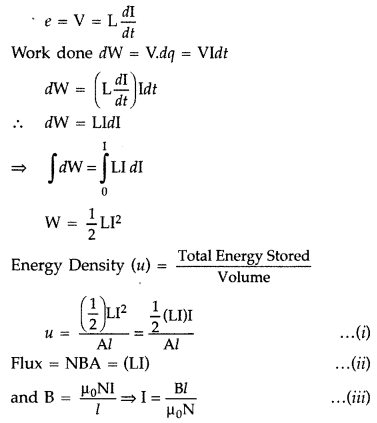
Putting the values of (LI) and (I) from equations (ii) and (iii) in equation (i), we have

Question 56.
The current, in the LCR circuit shown in the figure is observed to lead the voltage in phase. Without making any other change in the circuit, a capacitor, of capacitance C
0
, is (appropriately) joined to the capacitor C. This results in making the current, in the ‘modified’ circuit, flow in phase with the applied voltage.
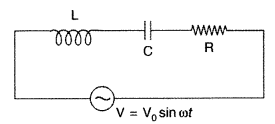
Draw a diagram of the ‘modified’ circuit and obtain an expression for C
0
in terms of ω, L and C. (Comptt. All India)
Answer:
Since the current leads the voltage in phase, hence, X
C
> X
L
For resonance, we must have
New value of X’
C
= X
L

This requires an increase in the value of C. Hence, capacitor C
0
should be connected in parallel across C.
The diagram of the modified circuit is shown. For resonance, we then have
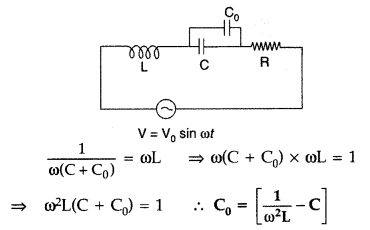
Question 57.
A 200 mH (pure) inductor, and a 5µF (pure) capacitor, are connected, one by one, across a sinusoidal ac voltage source V = [70.7 sin (1000 t)] voltage. Obtain the expressions for the current in each case. (Comptt. All India 2016)
Answer:
Given: For the applied voltage V = 70.7 sin(1000 t),
we have V
0
= 70.7 volts, ω = 1000s
-1
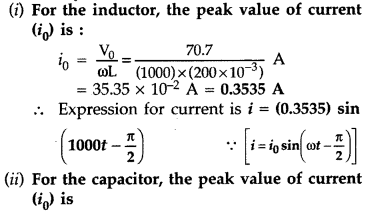
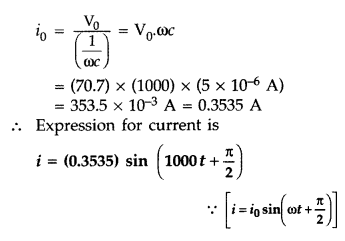
Question 58.
(i) Find the value of the phase difference between the current and the voltage in the series LCR circuit shown here. Which one leads in phase: current or voltage?
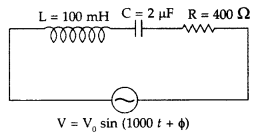
(ii) Without making any other change, find the value of the additional capacitor Cv to be connected in parallel with the capacitor C, in order to make the power factor of the circuit unity. (Delhi 2017)
Answer:
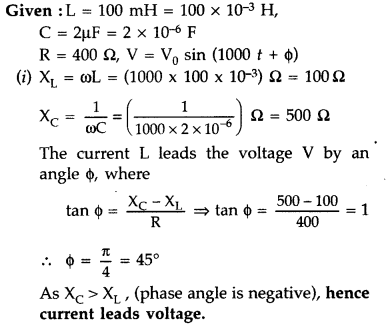
(ii) To make power factor unity, ϕ = 0°, hence we need to adjust C to a new value C’, the condition is :
X
C
= X
L
= 100 Ω
Thus, phase angle is 45° with the current leading the voltage.
To make power factor unity, we need to have X C also equal to 100 Ω. For this, C needs to have a value of 10µ.
down
a
Question 59.
An a.c. source generating a voltage v = v
m
sin ω t is connected to a capacitor of capacitance C. Find the expression for the current, i, flowing through it. Plot a graph of v and i versus tat to show that the current is π/2 ahead of the voltage. A resistor of 200Ω and a capacitor of 15.0 µF are connected in series to a 220 V, 50 Hz a.c. source. Calculate the current in the circuit and the rms voltage across the resistor and the capacitor. Is the algebraic sum of these voltages more than the source voltage? If yes, resolve the paradox. (All India 2008)
Answer:
(a) Voltage applied to the capacitor, v = v
m
sin ωt
Let instantaneous capacitor = v
we have, v = \(\frac{q}{C}\)
![]()
According to Kirchoff’s loop rule, the voltage across the source and the capacitor are equal at any instant of time.
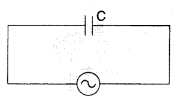
From equations (i) and (ii) we conclude that current leads the voltage by a phase angle of π/2
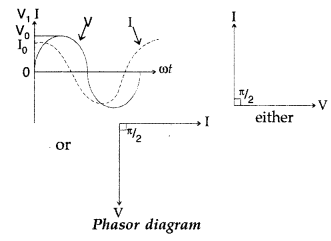
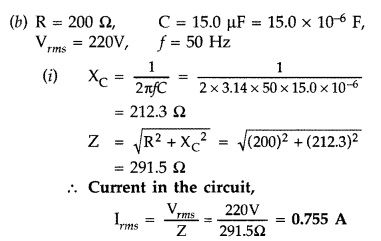
(ii) As the current is same throughout the series circuit, we have

The algebraic sum of the two voltages, V
R
and V
C
is 311.3 V which is more than the source voltage of 220 V. These two voltages are 90° out of phase. These cannot be added like ordinary numbers. The voltage is obtained by using Pythagoras theorem,

Thus if the phase difference between two voltages is properly taken into account, the total voltage across the resistor and the capacitor is equal to the voltage of the source.
Question 60.
Explain briefly, with the help of a labelled diagram, the basic principle of the working of an a.c. generator.
In an a.c. generator, coil of N turns and area A is rotated at v revolutions per second in a uniform magnetic field B. Write the expression for the emf produced.
A 100-turn coil of area 0.1 m2 rotates at half a revolution per second. It is placed in a magnetic field 0.01 T perpendicular to the axis of rotation of the coil. Calculate the maximum voltage generated in the coil. (All India 2008)
Answer:
(a) Principle of A.C. generator : The working of an a.c. generator is based on the principle of electromagnetic induction. When a closed coil is rotated in a uniform magnetic field with its axis perpendicular to the magnetic field, the magnetic flux linked with the coil changes and an induced emf and hence a current is set up in it.
(b) Let N = number of turns in the coil
A = Area of face of each turn
B = magnitude of the magnetic field
θ = angle which normal to the coil makes with field B at any instant
ω = the angular velocity with which coil rotates

The magnetic flux linked with the coil at any instant f will be,
ϕ = NAB cos θ = NAB cos ωt
By Faraday’s flux rule, the induced emf is given by,

When a load of resistance R is connected across the terminals, a current I flows in the external circuit.

Question 61.
(a) Derive an expression for the average power consumed in a series LCR circuit connected to a.c. source in which the phase difference between the voltage and the current in the circuit is 0.
(b) Define the quality factor in an a.c. circuit. Why should the quality factor have high value in receiving circuits? Name the factors on which it depends. (Delhi 2009)
Answer:
(a) Let an alternating current I = I
m
sin cot be passing through a network of L, C and R creating a potential difference of V = V
m
sin (ωt ± ϕ ) where ϕ is the phase difference. Then the power consumed is
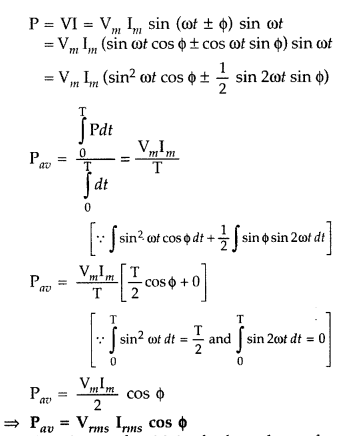
(b) Quality factor should be high to have the current corresponding to a particular frequency to be more and to avoid the other unwanted frequencies. Q-factor depends on f, L, R and C.
Sharpness of resonance is determined by quality factor (Q) of the circuit i.e.,
![]()
Larger the value of Q,
Sharper is the resonance i.e. sharper peak in the current.
Question 62.
(a) Derive the relationship between the peak and the rms value of current in an a.c. circuit.
(b) Describe briefly, with the help of a labelled diagram, working of a step-up transformer. A step-up transformer converts a low voltage into high voltage. Does it not violate the principle of conservation of energy? Explain. (Delhi 2009)
Answer:
(a) R.M.S. value of current say I = I
m
sin ωt is given by
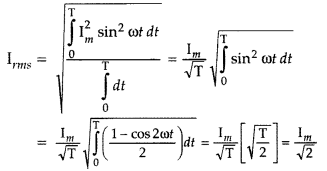
where [I
m
is the peak value of current]
(b) The supply of ac to the primary will bring a varying flux in the secondary causing emf.
![]()
in the secondary flux will be more than the primary as the condition N
S
> N
P
is satisfied. Production of high voltage does not violate the law of conservation of energy as the current will be reduced in the process.
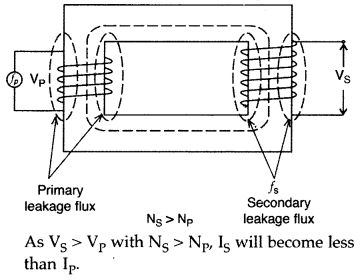
As V
S
> V
P
with N
S
> N
P
, I
S
will become less than I
P
.
Question 63.
Describe briefly, with the help of a labelled diagram, the basic elements of an a.c. generator. State its underlying principle. Show diagrammatically how an alternating emf is generated by a loop of wire rotating in a magnetic field. Write the expression for the instantaneous value of the emf induced in the rotating loop. (Delhi 2010)
Answer:
(a) Principle of A.C. generator : The working of an a.c. generator is based on the principle of electromagnetic induction. When a closed coil is rotated in a uniform magnetic field with its axis perpendicular to the magnetic field, the magnetic flux linked with the coil changes and an induced emf and hence a current is set up in it.
(b) Let N = number of turns in the coil
A = Area of face of each turn
B = magnitude of the magnetic field
θ = angle which normal to the coil makes with field B at any instant
ω = the angular velocity with which coil rotates

The magnetic flux linked with the coil at any instant f will be,
ϕ = NAB cos θ = NAB cos ωt
By Faraday’s flux rule, the induced emf is given by,

When a load of resistance R is connected across the terminals, a current I flows in the external circuit.

Diagram of how an alternating emf is generated by a loop of wire

Question 64.
A series LCR circuit is connected to an a.c. source having voltage v = v
m
sin ωt.
Derive the expression for the instantaneous current I and its phase relationship to the applied voltage.
Obtain the condition for resonance to occur. Define ‘power factor’. State the conditions under which it is
(i) maximum and
(ii) minimum. (Delhi 2010)
Answer:
(a) Suppose a resistance R, an inductance L and capacitance C are connected in series to a source of alternating emf ε given by
ε = ε
0
sin ωt
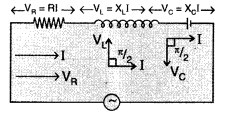
Let I be the instantaneous value of current in the series circuit. Then voltage across the three components are
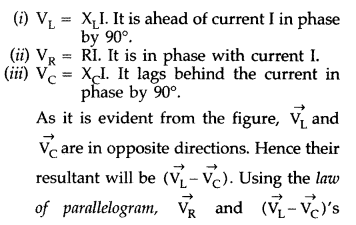
resultant is equal to the applied emf \(\vec{\varepsilon}\), as given by the diagonal of the parallelogram.
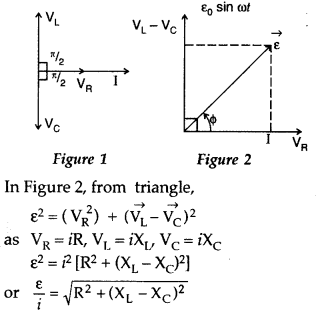
Clearly \(\frac{\varepsilon}{i}\) is the effective resistance of the series LCR circuit and is called its impedance (Z)
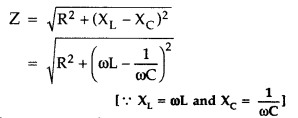
When X
L
= X
C
, the voltage and current are in the same phase. In such a situation, the circuit is known as non-inductive circuit.
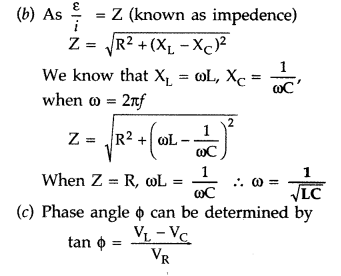
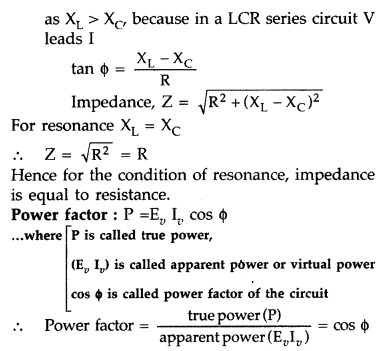
(i) Power factor is maximum when the circuit contains only resistance R. In that case ϕ = 0, cos ϕ = 1.
(ii) Power factor is minimum when the circuit contains purely capacitive or inductive circuit. In this case cos ϕ = 0 and no power is dissipated even though a current is flowing in the circuit.
Question 65.
Draw a schematic diagram of a step-up transformer. Explain its working principle. Deduce the expression for the secondary to primary voltage in terms of the number of turns in the two coils. In an ideal transformer, how is this ratio related to the currents in the two coils? How is the transformer used in large scale transmission and distribution of electrical energy over long distances? (All India 2010)
Answer:
A transformer is an electrical device for converting an alternating current at low voltages into that at high voltage or vice versa.
If it increases the input voltage, it is called step- up-transformer.

Principle : It works on the principle of mutual induction i.e., “when a changing current is passed through one of the two inductively coupled coils, an induced emf is set up in the other coil.”
Working : As the alternating current flows through the primary, it generates an alternating magnetic flux in the core which also passes through the secondary. This changing flux sets up an induced emf in the secondary, also a self- induced emf in the primary. If there is no leakage of magnetic flux, then flux linked with each turn of the primary will be equal to that linked with each turn of the secondary.
![]()
…where [N
p
and N
s
are number of turns in the primary and secondary respectively,
V
p
and V
s
are their respective voltages]

This ratio \(\frac{\mathrm{N}_{\mathrm{S}}}{\mathrm{N}_{\mathrm{P}}}\) is called the turns ratio.
Assuming the transformer to be ideal one, so that there are no energy losses, then
Input power = output power
V
p
l
p
= V
S
I
S
…where [I
P
and I
S
are the current in the primary and secondary respectively

In a step up transformer, N
s
> N
p
i.e., the turns ratio is greater than 1 and therefore V
s
> V
p
.
The output voltage is greater than the input voltage.
d.c.
- The primary resistance and current are small.
- The same flux links both with the primary and secondary windings as the flux leakage from due core is negligible (small).
- The terminals of the secondary are open or the current taken from it, is small, (any two)
voltage
Question 66.
(i) With the help of a labelled diagram, describe briefly the underlying principle and working of a step-up transformer.
(ii) Write any two sources of energy loss in a transformer.
(iii) A step up transformer converts a low input voltage into a high output voltage. Does it violate law of conservation of energy? Explain. (Delhi 2011)
Answer:
(i) A transformer is an electrical device for converting an alternating current at low voltages into that at high voltage or vice versa.
If it increases the input voltage, it is called step- up-transformer.

Principle : It works on the principle of mutual induction i.e., “when a changing current is passed through one of the two inductively coupled coils, an induced emf is set up in the other coil.”
Working : As the alternating current flows through the primary, it generates an alternating magnetic flux in the core which also passes through the secondary. This changing flux sets up an induced emf in the secondary, also a self- induced emf in the primary. If there is no leakage of magnetic flux, then flux linked with each turn of the primary will be equal to that linked with each turn of the secondary.
![]()
…where [N
p
and N
s
are number of turns in the primary and secondary respectively,
V
p
and V
s
are their respective voltages]

This ratio \(\frac{\mathrm{N}_{\mathrm{S}}}{\mathrm{N}_{\mathrm{P}}}\) is called the turns ratio.
Assuming the transformer to be ideal one, so that there are no energy losses, then
Input power = output power
V
p
l
p
= V
S
I
S
…where [I
P
and I
S
are the current in the primary and secondary respectively

In a step up transformer, N
s
> N
p
i.e., the turns ratio is greater than 1 and therefore V
s
> V
p
.
The output voltage is greater than the input voltage.
because
- The primary resistance and current are small.
- The same flux links both with the primary and secondary windings as the flux leakage from due core is negligible (small).
- The terminals of the secondary are open or the current taken from it, is small, (any two)
d.c.
(ii) Two sources of energy loss in a transformer:
1. Copper loss”: Some energy is lost due to heating of copper wires used in the primary and secondary windings. This power loss (= I
2
R) can be minimised by using thick copper wires of low resistance.
voltage
cannot
Question 67.
Derive an expression for the impedance of a series LCR circuit connected to an AC supply of variable frequency.
Plot a graph showing variation of current with the frequency of the applied voltage.
Explain briefly how the phenomenon of resonance in the circuit can be used in the tuning mechanism of a radio or a TV set. (Delhi 2011)
Answer:
Expression for impedance:
(a) Let an alternating current I = I
m
sin cot be passing through a network of L, C and R creating a potential difference of V = V
m
sin (ωt ± ϕ ) where ϕ is the phase difference. Then the power consumed is

(b) Quality factor should be high to have the current corresponding to a particular frequency to be more and to avoid the other unwanted frequencies. Q-factor depends on f, L, R and C.
Sharpness of resonance is determined by quality factor (Q) of the circuit i.e.,
![]()
Larger the value of Q,
Sharper is the resonance i.e. sharper peak in the current.
Resonant circuit can be used in the tuning mechanism of a radio or a TV set.
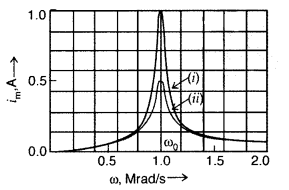
The antenna of a radio accepts signals from many broadcasting stations. The signals picked up in the antenna acts as a source in the tuning circuit of the radio, so the circuit can be driven at many frequencies. But to hear one particular radio station, we tune the radio. In tuning, we vary the capacitance of a capacitor in the tuning circuit such that the resonant frequency of the circuit becomes nearly equal to the frequency of the radio signal received. When this happens, the amplitude of the current with the frequency of the signal of the . particular radio station in the circuit is maximum.
Question 68.
State the working of a.c. generator with the help of a labelled diagram.
The coil of an a.c. generator having N turns, each of area A, is rotated with a constant angular velocity to. Deduce the expression for the alternating emf generated in the coil.
What is the source of energy generation in this device? (All India 2011)
Answer:
AC generator: A dynamo or generator is a device which converts mechanical energy into electrical energy. It is based on the principal of electromagnetic energy into electrical energy. It is based on the principle of electromagnetic induction.
Construction : It consists of the four main parts :
(i) Field Magnet : It produces the magnetic field. In the case of a low power dynamo, the magnetic field is generated by a permanent magnet, while in the case of large power dynamo, the magnetic field is produced by an electromagnet. ;
produce
- It serves as support to coils and
- It increases the magnetic field due to air core being replaced by an iron core.
(iii) Slip Rings : The slip rings R 1 and R 2 are the two metal rings to which the ends of armature coil are connected. These rings are fixed to the shaft which rotates the armature coil so that the rings also rotate along with the armature.
(iv) Brushes : These are two flexible metal plates or carbon rods (B
1
and B
2
) which are fixed and constantly touch the revolving rings. The output current in external load RL is taken through these brushes.
Working : When the armature coil is rotated in the strong magnetic field, the magnetic flux linked with the coil changes and the current is induced in the coil, its direction being given by Fleming’s right hand rule. Considering the armature to be in vertical position and as it rotates in anticlockwise direction, the wire ab moves upward and cd downward, so that the direction of induced current is shown in fig. In the external circuit, the current flows along B
1
R
L
B
2
. The direction of current remains unchanged during the first half turn of armature. During the second half revolution, the wire ab moves downward and cd upward, so the direction of current is reversed and in external circuit it flows along B
2
R
L
B
1
. Thus the direction of induced emf and current changes in the external circuit after each half revolution.
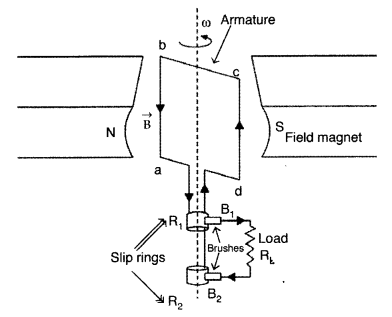
Numerical :
N = number of turns in the coil
A = area enclosed by each turn of coil
\(\overrightarrow{\mathrm{B}}\) = strength of magnetic field
θ = angle, which is normal to the coil, makes with \(\overrightarrow{\mathrm{B}}\) at any instant t
∴ Magnetic flux linked with the coil in this position
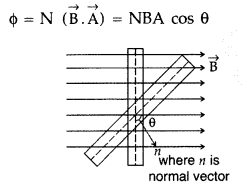
If the coil rotates with an angular velocity ω and turns through an angle θ in time t

Source of energy : This induced emf is the source of energy generations in this device.
Question 69.
(a) A voltage V = V
0
sin ωt applied to a series LCR circuit drives a current i = i
0
sin ωt in the circuit. Deduce the expression for the average power dissipated in the circuit.
(b) For circuits used for transporting electric power, a low power factor implies large power loss in transmission. Explain.
(c) Define the term ‘wattless current’. (Comptt. Delhi 2012)
Answer:

If the instantaneous power remains constant for a small time dt
then small amount of work done in maintaining the current for a small time dt is,
dW = V
0
i
0
sin
2
ωtdt
Total work done or energy spent in maintaining current over one full cycle,
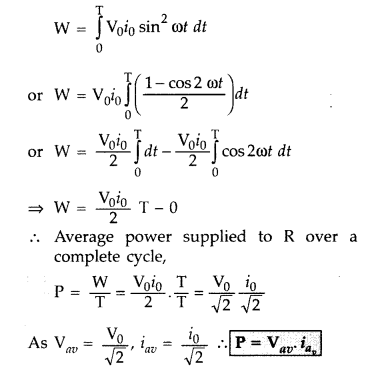
(b) A transformer is an electrical device for converting an alternating current at low voltages into that at high voltage or vice versa.
If it increases the input voltage, it is called step- up-transformer.

Principle : It works on the principle of mutual induction i.e., “when a changing current is passed through one of the two inductively coupled coils, an induced emf is set up in the other coil.”
Working : As the alternating current flows through the primary, it generates an alternating magnetic flux in the core which also passes through the secondary. This changing flux sets up an induced emf in the secondary, also a self- induced emf in the primary. If there is no leakage of magnetic flux, then flux linked with each turn of the primary will be equal to that linked with each turn of the secondary.
![]()
…where [N
p
and N
s
are number of turns in the primary and secondary respectively,
V
p
and V
s
are their respective voltages]

This ratio \(\frac{\mathrm{N}_{\mathrm{S}}}{\mathrm{N}_{\mathrm{P}}}\) is called the turns ratio.
Assuming the transformer to be ideal one, so that there are no energy losses, then
Input power = output power
V
p
l
p
= V
S
I
S
…where [I
P
and I
S
are the current in the primary and secondary respectively

In a step up transformer, N
s
> N
p
i.e., the turns ratio is greater than 1 and therefore V
s
> V
p
.
The output voltage is greater than the input voltage.
a
- The primary resistance and current are small.
- The same flux links both with the primary and secondary windings as the flux leakage from due core is negligible (small).
- The terminals of the secondary are open or the current taken from it, is small, (any two)
change
in
Question 70.
(a) An ac source of voltage v = v
0
sin ωt is connected across a series combination of an inductor, a capacitor and a resistor. Use the phasor diagram to obtain the expression for
(i) impedance of the circuit and
(ii) phase angle between the voltage and the current.
(b) A capacitor of unknown capacitance, a resistor of 100 Ω and an inductor of self-inductance L = (4/π
2
) henry are in series connected to an ac source of 200 V and 50 Hz. Calculate the value of the capacitance and the current that flows in the circuit when the current is in phase with the voltage. (Comptt. All India 2012)
Answer:
(a) (i) Impedance of circuit : The effective resistance offered by a series LCR circuit is called its impedance.
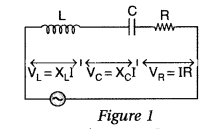
Suppose an inductance L, capacitance C and resistance R are connected in series to a source of alternating emf, V = V
0
sin ωt.
Let I be the instantaneous value of current in the series circuit.
Then voltages across the three components are : ‘
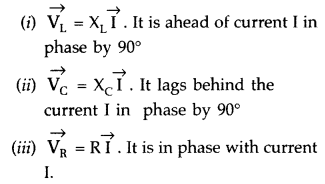
These voltages are shown in the phasor in Figure 2.
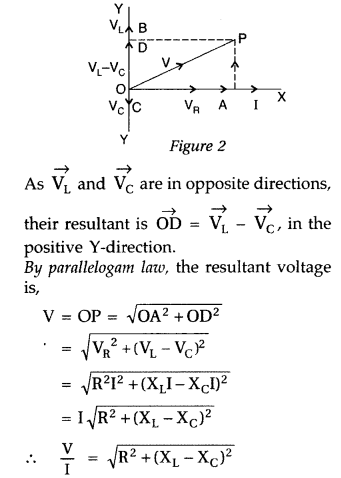
Clearly V/I is the effective resistance of the series LCR circuit and is called its impedance (Z).
![]()
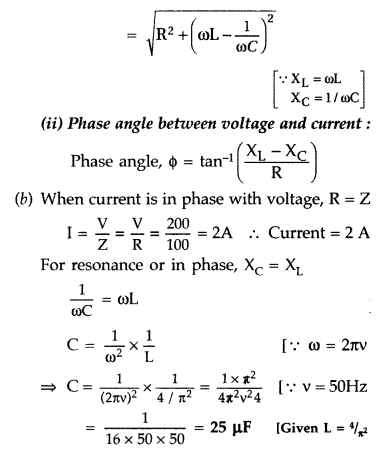
Question 71.
(a) Explain with the help of a labelled diagram, the principle and working of a transformer. Deduce the expression for its working formula.
(b) Name any four causes of energy loss in an actual transformer. (Comptt. All India 2012)
Answer:
(a) Principle. It is a device which converts high voltage a.c. into low voltage a.c. and vice versa. It is based upon the principle of mutual induction. When alternating current passes through a coil, an induced emf is set up in the neighbouring coil.
Construction. A transformer consists of two coils of many turns of insulated copper wire wound on a closed laminated iron core. One of the coils known as Primary ‘P’ is connected to A.C. supply. The other coil known as Secondary ‘S’ is connected to the load. Working. When an alternating current passes through the primary, the magnetic flux through the iron core changes which does two things. It produces emf in the primary and an induced emf is also set up in the secondary. If we assume that the resistance of primary is negligible, the back emf will be equal to the voltage applied to the primary.

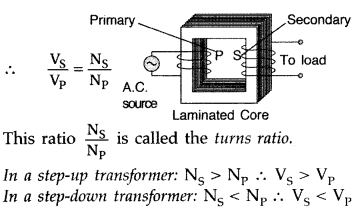
magnetic
- Magnetic flux loss
- Hystersis loss
- Iron loss
- Losses due to the resistance of primary and secondary coils.
Question 72.
(a) Draw a schematic sketch of an ac generator describing its basic elements. State briefly its working principle. Show a plot of variation of
(i) Magnetic flux and
(ii) Alternating emf versus time generated by a loop of wire rotating in a magnetic field.
(b) Why is choke coil needed in the use of fluorescent tubes with ac mains? (Delhi 2014)
Answer:
(a) AC generator.
(a) Principle of A.C. generator : The working of an a.c. generator is based on the principle of electromagnetic induction. When a closed coil is rotated in a uniform magnetic field with its axis perpendicular to the magnetic field, the magnetic flux linked with the coil changes and an induced emf and hence a current is set up in it.
(b) Let N = number of turns in the coil
A = Area of face of each turn
B = magnitude of the magnetic field
θ = angle which normal to the coil makes with field B at any instant
ω = the angular velocity with which coil rotates

The magnetic flux linked with the coil at any instant f will be,
ϕ = NAB cos θ = NAB cos ωt
By Faraday’s flux rule, the induced emf is given by,

When a load of resistance R is connected across the terminals, a current I flows in the external circuit.

flux
(ii) As the coil rotates, angle θ changes. Therefore, magnetic flux ϕ linked with the coil changes and an emf is induced in the coil. At this instant f, if e is the emf , induced in the coil, then
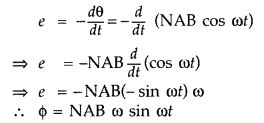
(iii) The graph between alternating emf ‘ versus time is shown below in Graph (ii).
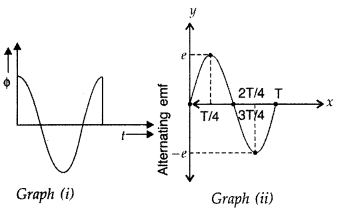
(b) A choke coil is an electrical appliance used for controlling current in a a.c. circuit. Therefore, if we use a resistance R for the same purpose, a lot of energy would be wasted in the form of heat etc.
Question 73.
(a) A series LCR circuit is connected to an a.c. source of variable frequency. Draw a suitable phasor diagram to deduce the expressions for the amplitude of the current and phase angle.
(b) Obtain the condition at resonance. Draw a plot showing the variation of current with the frequency of a.c. source for two resistances R
1
and (R
1
> R
2
). Hence define the quality factor, Q and write its role in the tuning of the circuit. (Comptt. Delhi 2014)
Answer:
(a) Suppose a resistance R, an inductance L and capacitance C are connected in series to a source of alternating emf ε given by
ε = ε
0
sin ωt

Let I be the instantaneous value of current in the series circuit. Then voltage across the three components are

resultant is equal to the applied emf \(\vec{\varepsilon}\), as given by the diagonal of the parallelogram.

Clearly \(\frac{\varepsilon}{i}\) is the effective resistance of the series LCR circuit and is called its impedance (Z)

When X
L
= X
C
, the voltage and current are in the same phase. In such a situation, the circuit is known as non-inductive circuit.


(i) Power factor is maximum when the circuit contains only resistance R. In that case ϕ = 0, cos ϕ = 1.
(ii) Power factor is minimum when the circuit contains purely capacitive or inductive circuit. In this case cos ϕ = 0 and no power is dissipated even though a current is flowing in the circuit.
(b)
(a) Condition for resonance to occur is X
L
= X
c
, and Z = R.
(b) Sharper resonance is produced for Rr
(c) The Q-factor (quality factor) of series resonant circuit is defined as the ratio of the voltage developed across the inductance of capacitance at resonance to the impressed voltage, which is the voltage applied across the R.

Significance : Higher the value of Q, the narrower and sharper is the resonance and therefore circuit will be more selective
Question 74.
(a) Draw a labelled diagram of a.c. generator and state its working principle.
(b) How is magnetic flux linked with the armature coil changed in a generator?
(c) Derive the expression for maximum value of the induced emf and state the rule that gives the direction of the induced emf.
(d) Show the variation of the emf generated
versus time as the armature is rotated with respect to the direction of the magnetic field. (Comptt. Delhi 2014)
Answer:
(a) Principle of A.C. generator : The working of an a.c. generator is based on the principle of electromagnetic induction. When a closed coil is rotated in a uniform magnetic field with its axis perpendicular to the magnetic field, the magnetic flux linked with the coil changes and an induced emf and hence a current is set up in it.
(b) Let N = number of turns in the coil
A = Area of face of each turn
B = magnitude of the magnetic field
θ = angle which normal to the coil makes with field B at any instant
ω = the angular velocity with which coil rotates

The magnetic flux linked with the coil at any instant f will be,
ϕ = NAB cos θ = NAB cos ωt
By Faraday’s flux rule, the induced emf is given by,

When a load of resistance R is connected across the terminals, a current I flows in the external circuit.

(c) Direction of induced emf can be determined by using Fleming’s Left hand rule.
(d)
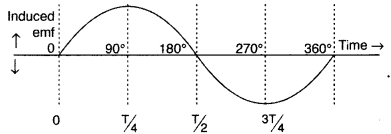
Question 75.
(a) Draw a schematic arrangement for winding of primary and secondary coil in a transformer when the two coils are wound on top of each other.
(b) State the underlying principle of a transformer and obtain the expression for the ratio of secondary to primary voltage in terms of the
(i) number of secondary and primary windings and
(ii) primary and secondary currents.
(c) Write the main assumption involved in deriving the above relations.
(d) Write any two reasons due to which energy losses may occur in actual transformers. (Comptt. All India 2014)
Answer:
A transformer is an electrical device for converting an alternating current at low voltages into that at high voltage or vice versa.
If it increases the input voltage, it is called step- up-transformer.

Principle : It works on the principle of mutual induction i.e., “when a changing current is passed through one of the two inductively coupled coils, an induced emf is set up in the other coil.”
Working : As the alternating current flows through the primary, it generates an alternating magnetic flux in the core which also passes through the secondary. This changing flux sets up an induced emf in the secondary, also a self- induced emf in the primary. If there is no leakage of magnetic flux, then flux linked with each turn of the primary will be equal to that linked with each turn of the secondary.
![]()
…where [N
p
and N
s
are number of turns in the primary and secondary respectively,
V
p
and V
s
are their respective voltages]

This ratio \(\frac{\mathrm{N}_{\mathrm{S}}}{\mathrm{N}_{\mathrm{P}}}\) is called the turns ratio.
Assuming the transformer to be ideal one, so that there are no energy losses, then
Input power = output power
V
p
l
p
= V
S
I
S
…where [I
P
and I
S
are the current in the primary and secondary respectively

In a step up transformer, N
s
> N
p
i.e., the turns ratio is greater than 1 and therefore V
s
> V
p
.
The output voltage is greater than the input voltage.
.
- The primary resistance and current are small.
- The same flux links both with the primary and secondary windings as the flux leakage from due core is negligible (small).
- The terminals of the secondary are open or the current taken from it, is small, (any two)
Falk:
transformer
- Flux leakage
- Losses due to the resistance of primary and secondary coils
- eddy currents
- hystersis
Question 76.
(i) An a.c. source of voltage V = V
0
sin ωt is connected to a series combination of L, C and R. Use the phasor diagram to obtain expressions for impedance of the circuit and phase angle between voltage and current. Find the condition when current will be in phase with the voltage. What is the circuit in this condition called?
(ii) In a series LR circuit X
L
= R and power factor of the circuit is P
1
. When capacitor with capacitance C such that X
L
= X
C
is put in series, the power factor becomes P
2
. Calculate P
1
/P
2
.
Answer:
(a) (i) Impedance of circuit : The effective resistance offered by a series LCR circuit is called its impedance.

Suppose an inductance L, capacitance C and resistance R are connected in series to a source of alternating emf, V = V
0
sin ωt.
Let I be the instantaneous value of current in the series circuit.
Then voltages across the three components are : ‘

These voltages are shown in the phasor in Figure 2.

Clearly V/I is the effective resistance of the series LCR circuit and is called its impedance (Z).
![]()

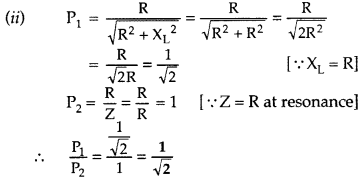
Question 77.
(i) Write the function of a transformer. State its principle of working with the help of a diagram. Mention various energy losses in this device.
(ii) The primary coil of an ideal step up transformer has 100 turns and transformation ratio is also 100. The input voltage and power are respectively 220 V and 1100 W. Calculate
(a) number of turns in secondary
(b) current in primary
(c) voltage across secondary
(d) current in secondary
(e) power in secondary (Delhi 2016)
Answer:
(i) (a) Principle. It is a device which converts high voltage a.c. into low voltage a.c. and vice versa. It is based upon the principle of mutual induction. When alternating current passes through a coil, an induced emf is set up in the neighbouring coil.
Construction. A transformer consists of two coils of many turns of insulated copper wire wound on a closed laminated iron core. One of the coils known as Primary ‘P’ is connected to A.C. supply. The other coil known as Secondary ‘S’ is connected to the load. Working. When an alternating current passes through the primary, the magnetic flux through the iron core changes which does two things. It produces emf in the primary and an induced emf is also set up in the secondary. If we assume that the resistance of primary is negligible, the back emf will be equal to the voltage applied to the primary.


(b) Four causes of energy loss :
- Magnetic flux loss
- Hystersis loss
- Iron loss
- Losses due to the resistance of primary and secondary coils.
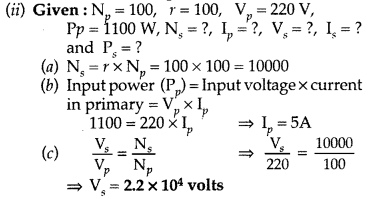
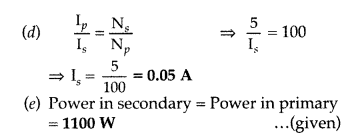
Question 78.
(i) Draw a labelled diagram of a step-down transformer. State the priciple of its working.
(ii) Express the turn ratio in terms of voltages.
(iii) Find the ratio of primary and secondary currents in terms of turn ratio in an ideal transformer
(iv) How much current is drawn by the primary of a transformer connected to 220 V supply when it delivers power to a 110V – 550 W refrigerator? (All India 2016)
Answer:
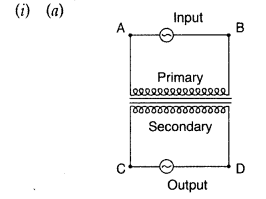
cannot
(b) Mutual Induction, which means “whenever an alternative voltage is applied in the primary windings /coil, an emf is induced in the secondary windings (Coil).”
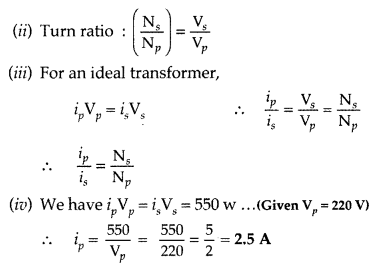
Question 79.
Discuss how Faraday’s law of e.m. induction is applied in an ac-generator for converting mechanical energy into electrical energy.
Obtain an expression for the instantaneous value of the induced emf in an ac generator. Draw graphs to show the ‘phase relationship’ between the instantaneous
(i) magnetic flux (ϕ) linked with the coil and
(ii) induced emf (ε) in the coil. ‘ (Comptt. Delhi 2016)
Answer:
Faradays law of e.m. induction and expression for instantaneous value of induced emf
(a) Principle of A.C. generator : The working of an a.c. generator is based on the principle of electromagnetic induction. When a closed coil is rotated in a uniform magnetic field with its axis perpendicular to the magnetic field, the magnetic flux linked with the coil changes and an induced emf and hence a current is set up in it.
(b) Let N = number of turns in the coil
A = Area of face of each turn
B = magnitude of the magnetic field
θ = angle which normal to the coil makes with field B at any instant
ω = the angular velocity with which coil rotates

The magnetic flux linked with the coil at any instant f will be,
ϕ = NAB cos θ = NAB cos ωt
By Faraday’s flux rule, the induced emf is given by,

When a load of resistance R is connected across the terminals, a current I flows in the external circuit.

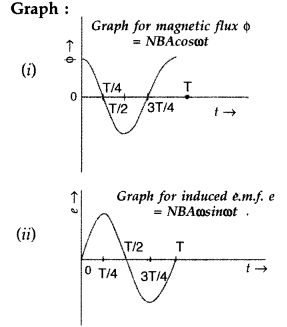
Question 80.
Draw an arrangement for winding of primary and secondary coils in a transformer with two coils on a separate limb of the core.
State the underlying principle of a transformer. Deduce the expression for the ratio of secondary voltage to the primary voltage in terms of the ratio of the number of turns of primary and secondary winding. For an ideal transformer, obtain the ratio of primary and secondary currents in terms of the ratio of the voltages in the secondary and primary voltages.
Write any two reasons for the energy losses which occur in actual transformers. (Comptt. Delhi 2016)
Answer:
(a) Principle. It is a device which converts high voltage a.c. into low voltage a.c. and vice versa. It is based upon the principle of mutual induction. When alternating current passes through a coil, an induced emf is set up in the neighbouring coil.
Construction. A transformer consists of two coils of many turns of insulated copper wire wound on a closed laminated iron core. One of the coils known as Primary ‘P’ is connected to A.C. supply. The other coil known as Secondary ‘S’ is connected to the load. Working. When an alternating current passes through the primary, the magnetic flux through the iron core changes which does two things. It produces emf in the primary and an induced emf is also set up in the secondary. If we assume that the resistance of primary is negligible, the back emf will be equal to the voltage applied to the primary.


(b) Four causes of energy loss :
- Magnetic flux loss
- Hystersis loss
- Iron loss
- Losses due to the resistance of primary and secondary coils.
Question 81.
(a) Draw a labelled diagram of AC generator. Derive the expression for the instantaneous value of the emf induced in the coil.
(b) A circular coil of cross-sectional area 200 cm
2
and 20 turns is rotated about the vertical diameter with angular speed of 50 rad s
-1
in a uniform magnetic field of magnitude 3.0 × 10
-2
T. Calculate the maximum value of the current in the coil. (Delhi 2017)
Answer:
(a) Principle of A.C. generator : The working of an a.c. generator is based on the principle of electromagnetic induction. When a closed coil is rotated in a uniform magnetic field with its axis perpendicular to the magnetic field, the magnetic flux linked with the coil changes and an induced emf and hence a current is set up in it.
(b) Let N = number of turns in the coil
A = Area of face of each turn
B = magnitude of the magnetic field
θ = angle which normal to the coil makes with field B at any instant
ω = the angular velocity with which coil rotates

The magnetic flux linked with the coil at any instant f will be,
ϕ = NAB cos θ = NAB cos ωt
By Faraday’s flux rule, the induced emf is given by,

When a load of resistance R is connected across the terminals, a current I flows in the external circuit.

(b) Given : A = 200 cm
2
= 200 × 10
-4
m
2
N = 20 turns, ω = 50 rad s
-1
,
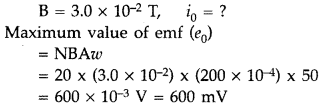
Maximum value of i
0
= mA
[ ∵ Numerical value of R is not given]
Question 82.
(a) Draw a labelled diagram of a step-up transformer. Obtain the ratio of secondary to primary voltage in terms of number of turns and currents in the two coils.
(b) A power transmission line feeds input power at 2200 V to a step-down transformer with its primary windings having 3000 turns. Find the number of turns in the secondary to get the power output at 220 V. (Delhi 2017)
Answer:
(a) A transformer is an electrical device for converting an alternating current at low voltages into that at high voltage or vice versa.
If it increases the input voltage, it is called step- up-transformer.

Principle : It works on the principle of mutual induction i.e., “when a changing current is passed through one of the two inductively coupled coils, an induced emf is set up in the other coil.”
Working : As the alternating current flows through the primary, it generates an alternating magnetic flux in the core which also passes through the secondary. This changing flux sets up an induced emf in the secondary, also a self- induced emf in the primary. If there is no leakage of magnetic flux, then flux linked with each turn of the primary will be equal to that linked with each turn of the secondary.
![]()
…where [N
p
and N
s
are number of turns in the primary and secondary respectively,
V
p
and V
s
are their respective voltages]

This ratio \(\frac{\mathrm{N}_{\mathrm{S}}}{\mathrm{N}_{\mathrm{P}}}\) is called the turns ratio.
Assuming the transformer to be ideal one, so that there are no energy losses, then
Input power = output power
V
p
l
p
= V
S
I
S
…where [I
P
and I
S
are the current in the primary and secondary respectively

In a step up transformer, N
s
> N
p
i.e., the turns ratio is greater than 1 and therefore V
s
> V
p
.
The output voltage is greater than the input voltage.
be
- The primary resistance and current are small.
- The same flux links both with the primary and secondary windings as the flux leakage from due core is negligible (small).
- The terminals of the secondary are open or the current taken from it, is small, (any two)
used
(b) Given : V
p
= 2200 V, N
p
= 3000 turns,

Question 83.
A device ‘X’ is connected to an ac source V = V0 sin cot. The variation of voltage, current and power in one cycle is shown in the following graph:
(a) Identify the device ‘X’.
(b) Which of the curves A, B and C represent the voltage, current and the power consumed in the circuit? Justify your
answer.
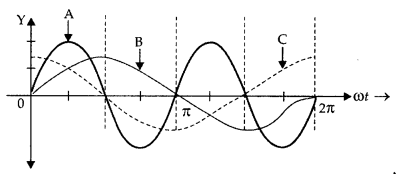
(c) How does it impedance vary with frequency of the ac source ? Show graphically.
(d) Obtain an expression for the current in the circuit and its phase relation with ac voltage. (All India 2017)
Answer:
(a) The device X is a capacitor.
(b) Curve B ➝ voltage
Curve C ➝ current
Curve A ➝ power consumption over a full cycle.
Reason: The current leads the voltage in phase, by a plane angle of \(\frac{\pi}{2}\), for a capacitor.

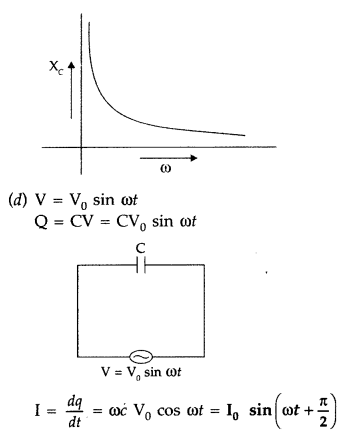
Current leads the voltage, in phase, by \(\frac{\pi}{2}\)
Question 84.
(a) Draw a labelled diagram of an ac generator.
Obtain the expression for the emf induced in the rotating coil of N turns each of cross-sectional area A, in the presence of a magnetic field \(\overrightarrow{\mathbf{B}}\).
(b) A horizontal conducting rod 10 m long extending from east to west is falling with a speed 5.0 ms
-1
at right angles to the horizontal component of the Earth’s magnetic field, 0.3 × 10
-4
Wb m
-2
. Find the instantaneous value of the emf induced in the rod. (All India 2017)
Answer:
(a) Principle of A.C. generator : The working of an a.c. generator is based on the principle of electromagnetic induction. When a closed coil is rotated in a uniform magnetic field with its axis perpendicular to the magnetic field, the magnetic flux linked with the coil changes and an induced emf and hence a current is set up in it.
(b) Let N = number of turns in the coil
A = Area of face of each turn
B = magnitude of the magnetic field
θ = angle which normal to the coil makes with field B at any instant
ω = the angular velocity with which coil rotates

The magnetic flux linked with the coil at any instant f will be,
ϕ = NAB cos θ = NAB cos ωt
By Faraday’s flux rule, the induced emf is given by,

When a load of resistance R is connected across the terminals, a current I flows in the external circuit.

(b) Given : l = 10 m, v = 5.0 ms
-1
,
B = 0.3 × 10
-4
wb m
-2
Induced emf = B/V
∴ E = (0.3 × 10
-4
) × (10) × (5) volt
E = 1.5 × 10
-3
V = 1.5 mV
Question 85.
In the given circuit, calculate
(a) the capacitance of the capacitor, if the power factor of the circuit is unity,
(b) the Q-factor of this circuit. What is the significance of the Q-factor in a.c. circuit? Given the angular frequency of the a.c. source to be 100/s. Calculate the average power dissipated in the circuit. (Comptt. Delhi 2017)
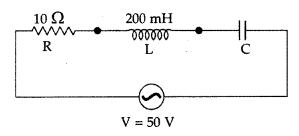
Answer:
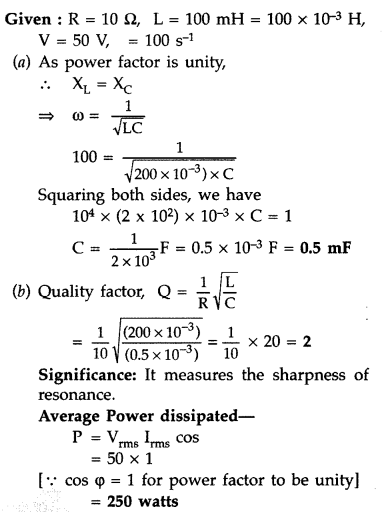
Question 86.
(a) Prove that the current flowing through an ideal inductor connected across a.c. source, lags the voltage in phase by \(\frac{\pi}{2}\).
(b) An inductor of self inductance 100 mH, and a bulb are connected in series with a.c. source of rms voltage 10 V, 50 Hz. It is found that effective voltage of the circuit \(\frac{\pi}{4}\). Calculate the inductance of the inductor used and average power dissipated in the circuit, if a current of 1 A flows in the circuit. (Comptt. Delhi)
Answer:
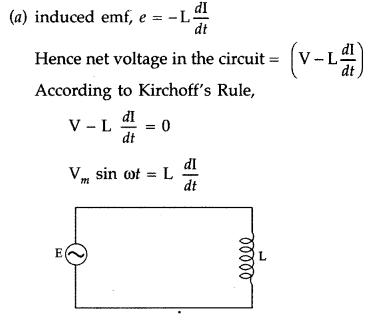
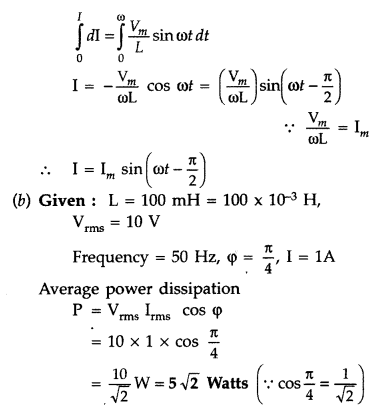
Question 87.
(a) Prove that an ideal capacitor in an ac circuit does not dissipate power.
(b) An inductor of 200 mH, capacitor of 400 f and a resistor of 10 Q are connected in series to ac source of 50 V of variable frequency. Calculate the
(i) angular frequency at which maximum power dissipation occurs in the circuit and the corresponding value of the effective current, and
(ii) value of Q-factor in the circuit. (Comptt. All India 2017)
Answer:
